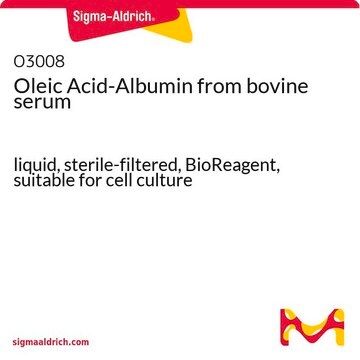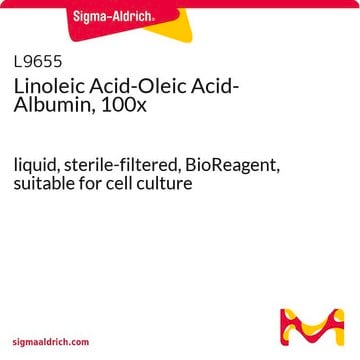This product is a neat or pure liquid and has not been diluted. This material has a density of 0.890 g/mL and a molecular weight of 282.46 g/mol. The minimum purity is 99%, thus the molarity will vary slightly from lot to lot. The molarity can range from 3.12 M (99%) to 3.15 M (100%).
O1383
Oleic acid
BioReagent, suitable for cell culture
Synonym(s):
cis-9-Octadecenoic acid, Elainic acid
Select a Size
Select a Size
About This Item
Recommended Products
biological source
palm oil
Quality Level
vapor pressure
1 mmHg ( 176 °C)
product line
BioReagent
Assay
≥99% (GC)
form
viscous liquid
technique(s)
cell culture | mammalian: suitable
refractive index
n20/D 1.459 (lit.)
bp
194-195 °C/1.2 mmHg (lit.)
mp
13-14 °C (lit.)
solubility
ethanol: soluble
density
0.89 g/mL at 25 °C (lit.)
0.89 g/mL at 25 °C (lit.)
storage temp.
−20°C
SMILES string
CCCCCCCC\C=C/CCCCCCCC(O)=O
InChI
1S/C18H34O2/c1-2-3-4-5-6-7-8-9-10-11-12-13-14-15-16-17-18(19)20/h9-10H,2-8,11-17H2,1H3,(H,19,20)/b10-9-
InChI key
ZQPPMHVWECSIRJ-KTKRTIGZSA-N
Gene Information
human ... SOAT1(6646) , SOAT2(8435)
Looking for similar products? Visit Product Comparison Guide
Related Categories
General description
Application
Packaging
Caution
Storage Class Code
10 - Combustible liquids
WGK
WGK 1
Personal Protective Equipment
Regulatory Listings
Regulatory Listings are mainly provided for chemical products. Only limited information can be provided here for non-chemical products. No entry means none of the components are listed. It is the user’s obligation to ensure the safe and legal use of the product.
FSL
Group 4: Flammable liquids
Type 3 petroleums
Hazardous rank III
Water insoluble liquid
JAN Code
O1383-1G:
O1383-BULK:
O1383-5G:
2515045:
O1383-25G:
O1383-VAR:
Choose from one of the most recent versions:
Certificates of Analysis (COA)
Don't see the Right Version?
If you require a particular version, you can look up a specific certificate by the Lot or Batch number.
Already Own This Product?
Find documentation for the products that you have recently purchased in the Document Library.
Customers Also Viewed
Articles
Lipid Induced Insulin Resistance
-
What is the concentration of this oleic acid and what solvent do I need to make dilution
1 answer-
Helpful?
-
-
What is the concentration of this product-O1383-25G?
1 answer-
The concentration of this product can be determined using the lot-specific purity reported in the Certificate of Analysis, as well as the density and compound molecular weight. This product has a density of 0.89 g/mL and a molecular weight of 282.46 g/mol. The minimum purity is 99%, thus the molarity will vary slightly from lot to lot. The molarity can range from 3.12 M (99%) to 3.15 M (100%).
Helpful?
-
-
Has product O1383-25g been received in a glass container or ampule?
1 answer-
Based on the packaging information, product O1383-25g has been received in a glass ampule.
Helpful?
-
Active Filters
Our team of scientists has experience in all areas of research including Life Science, Material Science, Chemical Synthesis, Chromatography, Analytical and many others.
Contact Technical Service








